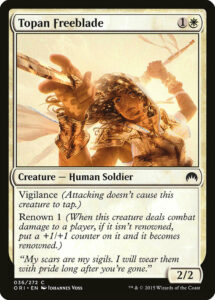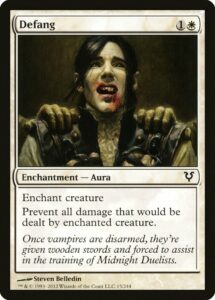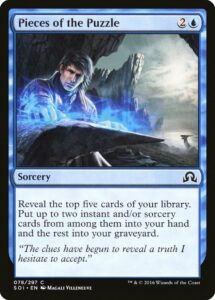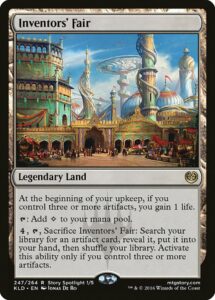Back in 2003, Magic introduced a cycle of five Sliths (with Slith Firewalker the strongest of the cycle). Each harkened back to Whirling Dervish from 1994’s Legends. All these creatures have a simple, appealing ability: deal damage to get counters. The quest is similarly simple—just hit the opponent. It’s an ideal quest to provide players as it encourages them to end the game and rewards them by making victory easier to attain.
The Slith mechanic remained unkeyworded when brought back as the vampire mechanic a decade later in 2011’s Innistrad. It was retooled in 2015’s Magic Origins as Renown. And there are echoes of it in Innistrad: Midnight Hunt’s vampires Stromkirk Bloodthief and Vampire Socialite. There’s a reason the mechanic has come back multiple times, but there are also good reasons why it’s never as good as it looks.
Snowballing
It’s fantastic to give your players quests. Having subgoals to strive for can guide players (especially newer players) into doing things that benefit them. They create accomplishment beyond the ultimate accomplishment (winning the game), which helps make games more enjoyable even when people don’t win. When done well, quests create a sense of individual ownership, where the player feels smart for how they chose to use their cards (even when they’ve followed a path the designers specifically carved for them). However, quests can be dangerous, especially when they’re too easy to achieve or provide too powerful a reward.
Snowballing is a game design term you might have heard—but we’re happy to redefine it for you. Imagine a little snowball rolling down a snow-covered mountain. As it rolls, it accumulates a little more snow. Now that it’s a little larger, it has a bigger surface area and accumulates snow faster. This process continues until what once was a tiny marble has grown into a mighty boulder. It’s great to have positive feedback loops like this (where you are rewarded for doing well), but too much reward leads to snowballing. In design terms, snowballing is when one small advantage leads to accruing too many advantages. You want the little ball to grow, but you don’t want it to trigger an avalanche by itself.
The Slith mechanic is in constant danger of snowballing. It’s a quest you can repeat endlessly. Each time you succeed, your creature gets bigger, making it even easier to succeed again. The risk is mitigated somewhat by being on creatures, the easiest card type to interact with; but it’s still a problem when every Slith demands an answer, especially Sliths that present a threat after a single hit. Heck, those who played Magic Origins know just hard it can be to stop a Renowned creature, and those only powered up the first time they hit. Granted, there are plenty of ways to rein in a risky combat mechanic, and each Innistrad has demonstrated them well.
Balancing around Sliths (and other pain-rewarding mechanics)
Every time there’s an aggressive mechanic designed around damaging the opponent, the format must be balanced around it. We’ve seen similar strategies used to balance Bloodthirst in Guildpact and M12, Spectacle in Ravnica Allegiance, Slith vampires in original Innistrad, and the Bloodthirst-y vampires of Innistrad: Midnight Hunt—even though the mechanics have different quests and rewards. We’ve also seen what happened when these mitigation measures failed against Topan Freeblade in Magic Origins.
When creatures get bigger and better after you’ve dealt damage, they tend to be costed such that they’re about half a mana better than you’d normally get. However, they’re usually half a mana to a full mana worse when you fail the quest. That means you get a minor-to-moderate advantage if you can reliably do damage, but you’re at a sizable disadvantage when you fail. It’s a simple but effective solution to the problem of snowballing—make the reward relatively small (compared to a similar creature without a quest) while increasing the penalty for failing the quest. It turns an all-upside mechanic into a risk-reward mechanic.
A second way to address the risk of aggression is by changing the creatures themselves. Creatures with high power and low toughness simply don’t benefit that much from a +1/+1 counter (if your opponent puts up any resistance). Almost any creature can stop a Bloodrage Vampire regardless of whether it’s been fed. You also see relatively few creatures that can snowball at mana value 2 or less—it’s so early on that if your opponent stumbles, you can run away with the game before they can put up a fight.
The final piece of the puzzle is interaction. If a color has creatures that get better when damage has been dealt, it usually gets worse removal than normal. This impedes its ability to win the game off a single Bloodcrazed Neonate and a pair of removal spells.
Putting it all together
There’s a reason BR vampires was one of the weaker tribes in original Innistrad and remains so in Innistrad: Midnight Hunt—it was intentionally and necessarily underpowered. Creatures like Erdwal Ripper and Rakish Heir needed to hit twice to really reward you (and were easy to block before they did so). Cards like Bat Whisperer are embarrassing without Bloodthirst and not especially impressive with it.
Midnight Hunt’s vampires are particularly weak because the quality of black and red removal is so high—if it’s so easy to force in a hit or two, the reward for hitting simply can’t be that big. Vampires are dependent on having a good curve, but the Bloodthirst/Slith rewards don’t actually start until turn 3, leading to clunkier curves and a greater likelihood of your opponent stopping you. (Starting at mana value 3 likely hurt RG werewolves even more than BR vampires, but it was even more necessary since triggering night by turn 3 can end the game before it’s even started.)
We’ve seen what happened in Magic Origins when Sliths were too powerful and interaction too weak: a turn 2 Topan Freeblade on the play was nearly impossible to block or remove. Aggressive mechanics in danger of snowballing must be easy to disrupt. They play better when they come with risks (which we’ve discussed today), but there are other methods to design them. The quest can be harder to achieve (Battalion, Mentor, and Coven). Or it can involve a finite resource (such as the Processors of Battle for Zendikar combined with Ingesters). Or it can have a cooldown period or fail state (Exert in Amonkhet and Landfall in every Zendikar). Or it can involve something not entirely in your control (as with Morbid and Revolt).
One of Magic’s great strengths is that it has so many opportunities to reinvent the wheel for each of its mechanics, even the humble and never-keyworded Slith mechanic. And while I may have pointed out all the risks (and mitigation methods) of aggressive mechanics today, I want to reiterate how vital they and other positive feedback mechanics are to Magic (and all games). Games must end. Ideally they end before anyone gets bored. That way, players are more likely to say, “that was fun! Wanna play again?” rather than “well, that was long.”
Mechanics that reward aggression make it far more likely that players will have fun, their cards will interact, and the game won’t overstay its welcome. At the same time, they can’t work too well, otherwise there will be no opportunities for interaction, nor will players really feel their choices won or lost them the game. When in doubt, it’s better for your creatures to dominate than game-delaying cards like Counterspells—but not so much that they snowball out of control.
Zachary Barash is a New York City-based game designer and the commissioner of Team Draft League. He designs for Kingdom Death: Monster, has a Game Design MFA from the NYU Game Center, and does freelance game design. When the stars align, he streams Magic (but the stars align way less often than he’d like).





